Description
The Hi Fin Checker Hawkfish (Plectranthias inermis) is a striking and colourful fish with a maximum size of around 4 inches (10 centimeters). It has a slender body with a high dorsal fin that gives it a unique and eye-catching appearance. The body colouration can vary, but it typically features a combination of vibrant red, yellow, and white markings.
Taxonomy:
The Hi Fin Checker Hawkfish belongs to the genus Plectranthias, which is a group of marine fish in the family Serranidae. It is classified under the species name Plectranthias inermis. Sometimes referred to as “Checkerboard Hawkfish”.
Natural Habitat:
In their natural habitat, Hi Fin Checker Hawkfish can be found in rocky reef areas with plenty of hiding spots and crevices. They are often observed perched on corals or rocks, using their pectoral fins to prop themselves up. These fish prefer areas with moderate water flow and can be found at various depths, ranging from 20 to 200 feet (6 to 60 meters).
Keeping The Hi Fin Checker Hawkfish Healthy:
The Hi Fin Checker Hawkfish requires attentive care and is considered moderately difficult to keep. They are sensitive to water quality, so maintaining stable parameters is crucial. Regular water changes, appropriate filtration, and monitoring of ammonia, nitrite, and nitrate levels are essential. The tank should be properly cycled before adding these fish.
Special Requirements and Feeding:
Hi Fin Checker Hawkfish are carnivorous and should be fed a varied diet consisting of high-quality frozen or live meaty foods. Suitable food options include small crustaceans, mysis shrimp, brine shrimp, and finely chopped fish. It is important to provide a balanced diet to ensure proper nutrition.
How Many Should I Keep:
Hi Fin Checker Hawkfish are generally kept individually or in mated pairs, as they can become territorial and aggressive towards conspecifics or similar-looking species. It is recommended to provide ample hiding places and territories if keeping multiple individuals.
Lighting Preference:
These hawkfish do well under moderate to high lighting conditions, as it helps enhance their vibrant colours and showcase their unique markings.
Suitable Tank Mates:
When choosing tank mates for Hi Fin Checker Hawkfish, it is important to consider their aggressive nature and territorial tendencies. They may not be suitable for reef tanks with delicate invertebrates or smaller, peaceful fish. Compatible tank mates can include other semi-aggressive fish species, larger peaceful fish, or similarly-sized hawkfish from different genera.
Reproduction in the Wild:
Hi Fin Checker Hawkfish reproduce through a process known as external fertilization. During the breeding season, which can vary depending on the location, the male hawkfish establishes a territory and displays courtship behaviours to attract a female. These behaviours often involve elaborate fin displays and colouration changes.
Breeding Plectranthias inermis:
- Set up:
Breeding Hi Fin Checker Hawkfish in captivity requires a well-maintained and appropriately sized aquarium with stable water parameters. The tank should include ample hiding places and suitable substrate for the fish to spawn.
- Courtship/Spawning:
The courtship process begins with the male displaying vibrant colours and fin movements to attract the female. Once courtship is successful, the pair will engage in a spawning ritual, where the female releases her eggs and the male simultaneously releases his sperm.
- Rearing:
After fertilization, the eggs are left to develop and hatch on their own. It is essential to provide optimal water conditions and maintain water quality during this period. Once the eggs hatch, the fry will enter a pelagic larval stage, where they require microscopic food such as rotifers and copepods.
Sexual Dimorphism:
Hi Fin Checker Hawkfish do not exhibit significant sexual dimorphism, meaning it is challenging to visually distinguish between males and females based on physical characteristics alone. In most cases, a closer examination or observation of their behaviour during the breeding season may be necessary for identification.
Distribution:
The Hi Fin Checker Hawkfish (Plectranthias inermis) is primarily found in the Pacific Ocean, specifically in regions such as Hawaii, Fiji, and the Western Pacific. While some individuals may be available as captive-bred or line-bred strains, the original fish in the wild are naturally occurring in these Pacific regions.
Summary:
The Hi Fin Checker Hawkfish (Plectranthias inermis) is a captivating fish known for its striking appearance, including its high dorsal fin and vibrant colours. They require attentive care and are considered moderately difficult to keep in aquariums. These hawkfish prefer rocky reef habitats with hiding spots and moderate water flow. Feeding them a varied diet of meaty foods is essential for their health and well-being. They may not be suitable for reef tanks with delicate invertebrates or smaller, peaceful fish due to their territorial nature. Breeding this species in captivity involves providing suitable tank conditions for courtship and spawning, followed by proper rearing of the eggs and fry. While sexual dimorphism is not pronounced in this species, observing courtship behaviors during the breeding season can help identify males and females. The Hi Fin Checker Hawkfish is naturally distributed in the Pacific Ocean, and while captive-bred strains may be available, their wild counterparts originate from regions such as Hawaii, Fiji, and the Western Pacific. These fish add beauty and intrigue to marine aquariums, but their care requires diligence and attention to ensure their well-being.
The Fish pictured here are representative only and the livestock you receive may vary in pattern, coloration, and shape.

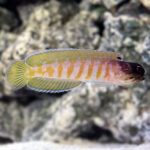

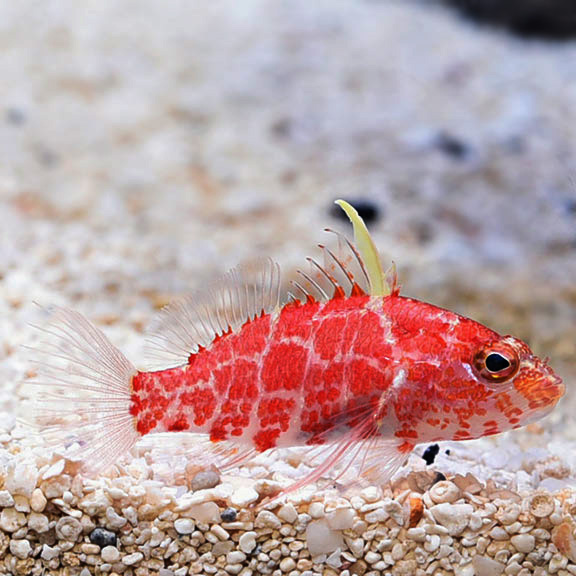

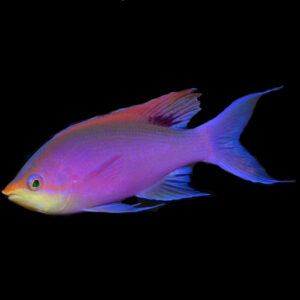

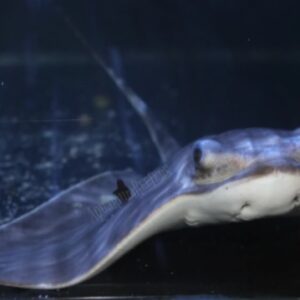
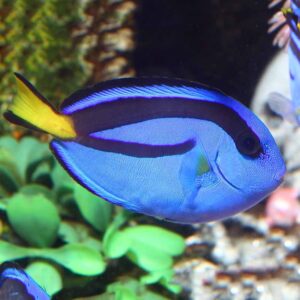
Reviews
There are no reviews yet.